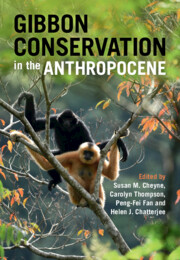Book contents
- Gibbon Conservation in the Anthropocene
- Gibbon Conservation in the Anthropocene
- Copyright page
- Contents
- Contributors
- Foreword
- Abbreviations
- Introduction
- 1 Taxonomy, Ecology and Conservation of Cao Vit Gibbon (Nomascus nasutus) since Its Rediscovery
- 2 Conservation Status of the Northern Yellow-Cheeked Crested Gibbon (Nomascus annamensis) in Vietnam
- 3 Strategies for Recovery of the Hainan Gibbon (Nomascus hainanus)
- 4 Gibbons in the Anthropocene
- 5 Demography of a Stable Gibbon Population in High-Elevation Forest on Java
- 6 A Tale of Two Gibbon Studies in Thailand
- 7 Accessibility as a Factor for Selecting Conservation Actions for Pileated Gibbons (Hylobates pileatus)
- 8 Calling from the Wild
- 9 Demography and Group Dynamics of Western Hoolock Gibbons (Hoolock hoolock) in a Community Conserved Village Population in Upper Assam, India
- 10 Challenges and Prospects in the Conservation of Hoolock Gibbon in India
- 11 Gibbons of Assam
- 12 Movement Ecology of Siamang in a Degraded Dipterocarp Forest
- 13 Sympatric Gibbons in Historically Logged Forest in North Sumatra, Indonesia
- 14 Adopting an Interdisciplinary Biosocial Approach to Determine the Conservation Implications of the Human–Gibbon Interface
- 15 Listen to the People, Hear the Gibbons Sing
- 16 Long-Term Outcomes of Positive Cultural Value for Biodiversity
- 17 Gibbon Phylogenetics and Genomics
- 18 The Use of Microsatellites in the Management of Captive Gibbons
- Index
- References
8 - Calling from the Wild
Mentawai Gibbon Conservation Fieldwork
Published online by Cambridge University Press: 13 April 2023
- Gibbon Conservation in the Anthropocene
- Gibbon Conservation in the Anthropocene
- Copyright page
- Contents
- Contributors
- Foreword
- Abbreviations
- Introduction
- 1 Taxonomy, Ecology and Conservation of Cao Vit Gibbon (Nomascus nasutus) since Its Rediscovery
- 2 Conservation Status of the Northern Yellow-Cheeked Crested Gibbon (Nomascus annamensis) in Vietnam
- 3 Strategies for Recovery of the Hainan Gibbon (Nomascus hainanus)
- 4 Gibbons in the Anthropocene
- 5 Demography of a Stable Gibbon Population in High-Elevation Forest on Java
- 6 A Tale of Two Gibbon Studies in Thailand
- 7 Accessibility as a Factor for Selecting Conservation Actions for Pileated Gibbons (Hylobates pileatus)
- 8 Calling from the Wild
- 9 Demography and Group Dynamics of Western Hoolock Gibbons (Hoolock hoolock) in a Community Conserved Village Population in Upper Assam, India
- 10 Challenges and Prospects in the Conservation of Hoolock Gibbon in India
- 11 Gibbons of Assam
- 12 Movement Ecology of Siamang in a Degraded Dipterocarp Forest
- 13 Sympatric Gibbons in Historically Logged Forest in North Sumatra, Indonesia
- 14 Adopting an Interdisciplinary Biosocial Approach to Determine the Conservation Implications of the Human–Gibbon Interface
- 15 Listen to the People, Hear the Gibbons Sing
- 16 Long-Term Outcomes of Positive Cultural Value for Biodiversity
- 17 Gibbon Phylogenetics and Genomics
- 18 The Use of Microsatellites in the Management of Captive Gibbons
- Index
- References
Summary
Mentawai gibbons (Hylobates klossii) are one of the nine species of gibbon in Indonesia, all of which are threatened with extinction. We present a view of the future for gibbons on the Mentawai Islands using information from previous research as well as recent surveys. The largest gibbon population and habitat is currently in the Siberut National Park area, with approximately 10,484 individuals. In addition, there are 13 locations outside the national park with densities ranging from 1.04 groups/km2 to 4.01 groups/km2. A serious threat to the Mentawai gibbon is forest loss and hunting. Our survey also shows that the cultural value of Mentawai gibbons is being lost due to acculturation with modern culture. Uma (the Mentawai longhouse) and sikerei (the Mentawai shaman) are cultural symbols that are no longer found on the islands of Sipora and North and South Pagai. Currently there are only 94 uma and 135 sikerei (who have an average age of 64 years) on Siberut Island. We recommend conservation activities at the grassroots level for the Mentawai gibbon, activities that encourage local community capacity development and enhance the local economy, whilst at the same time strengthening Mentawai cultural and customary values.
- Type
- Chapter
- Information
- Gibbon Conservation in the Anthropocene , pp. 124 - 130Publisher: Cambridge University PressPrint publication year: 2023

